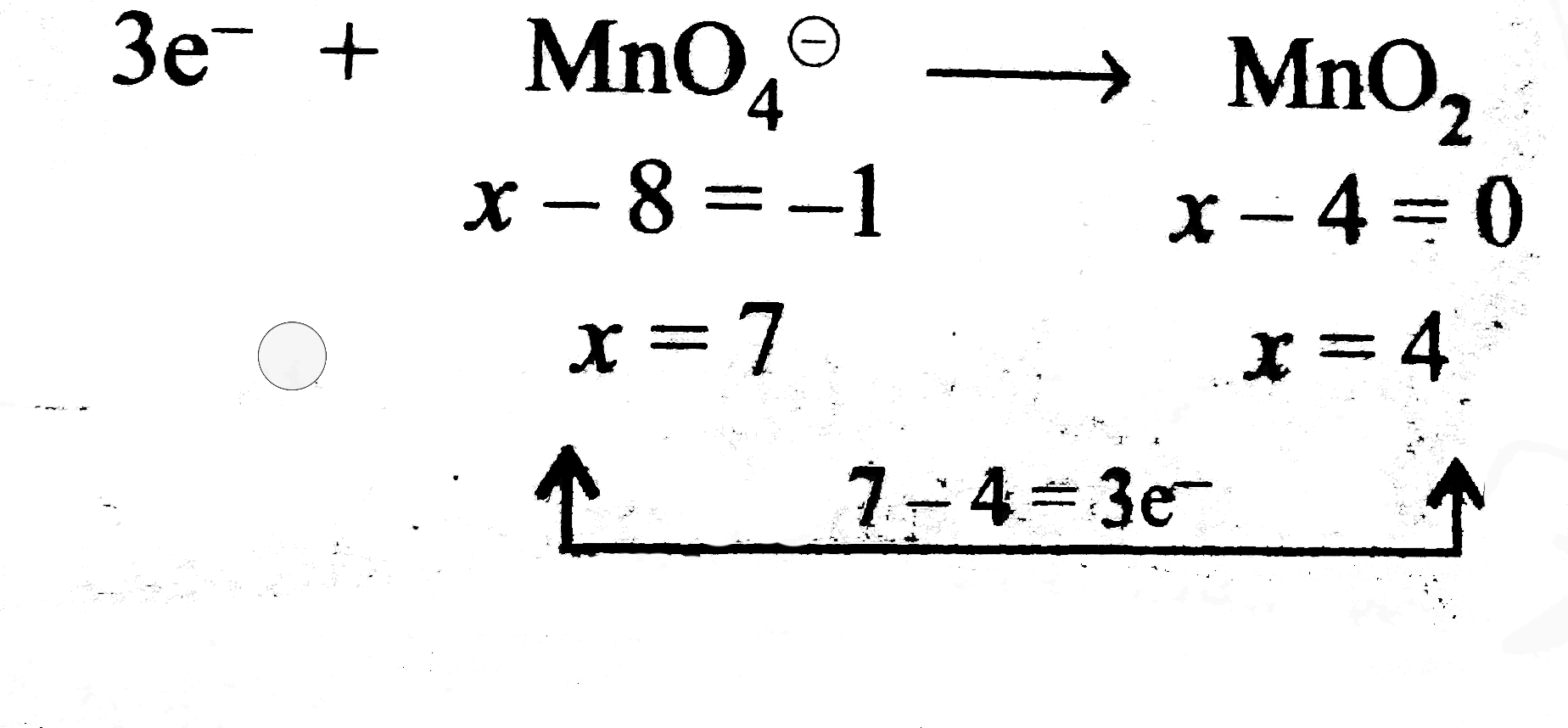Balance the following redox reactions by ion-electron method.
MnO−4(aq)+I−(aq)→MnO2(s)+I2(s) (in basic medium)
a. Balancing of reduction half equation
i. 
ii. Balance atoms by adding 2H2O to RHS of equation (i)
3e−+MnOΘ4→MnO2+2H2O
iii. Balance H atoms by adding 4H2O to LHS and add simultaneously of 4ΘOH to RHS (basic medium)
overset(2)cancel(4H_(2)O)+3e^(-)+MnO_(4)^(Θ)rarrMnO_(2)+cancel(2H_(2)O)+4overset(Θ)OH
iv. Balancing of oxidation half equation
2IΘ→I2e−
v. Multiply equation (iii) by 2 and equation (iv) by 3 and add them
{:(4H_(2)O+cancel(6e^(-))+2MnO_(2)+8overset(Θ)OH),(6I^(Θ)rarr3I_(2)+cancel(6e^(-))),(ulbar(4H_(2)O+6I^(Θ)+2MnO_(4)^(Θ)rarr2MnO_(2)+8overset(Θ)OH)):}
b. The balanced half reactions are:
Oxidation half equation:
SO2(g)+2H2O(l)→HSOΘ4(aq)+3H⊕(aq)+2e−....(i)
Reduction half equation:
MnOΘ4(aq)+8H⊕(aq)+5e−→Mn2+(aq)+4H2O(l) ...(ii)
Multiply equation (i) by 5 and add it to equation (ii) by 2 and add, we have,
2MnOΘ4(aq)+5SO2(g)+2H2O(l)+H⊕→2Mn2+(aq)+5HSOΘ4(aq)
c. Oxidation half equation: ltbr Fe2+(aq)→Fe3+(aq)+e−...(i)
Reduction half equation: H2O2(aq)+2Fe+2(aq)+2H⊕(aq)+2e−→2H2O(l).....(ii)
Multiply equation (i) by 2 and add it to equation (ii), we have,
H2O2(aq)+2Fe+2(aq)+2H⊕(aq)→2Fe3+(aq)+2H2O(l)
d. Oxidation half equation:
SO2(g)+2H2O(l)→SO2−4(aq)+4H⊕(aq)+2e−.....(i)
Reduction half equation
Cr2O2−7(aq)+14H⊕(aq)+6e−→2Cr3+(aq)+7H2O(l)..(ii)
Multiply equation (i) and add it to equation (ii), we have,
Cr2O2−7(aq)+3SO2(q)+2H⊕→2Cr3+(aq)+3SO2−4(aq)+H2O(l)
Topper's Solved these Questions
- NCERT BASED EXERCISEBOOK - CENGAGE CHEMISTRY ENGLISHCHAPTER - NCERT BASED EXERCISEEXERCISE - Atomic Structure
94 Videos
- NCERT BASED EXERCISEBOOK - CENGAGE CHEMISTRY ENGLISHCHAPTER - NCERT BASED EXERCISEEXERCISE - Thermodynamics
50 Videos
- NCERT BASED EXERCISEBOOK - CENGAGE CHEMISTRY ENGLISHCHAPTER - NCERT BASED EXERCISEEXERCISE - Chemical Equilibrium
73 Videos
- ISOMERISMBOOK - CENGAGE CHEMISTRY ENGLISHCHAPTER - ISOMERISMEXERCISE - Assertion-Reasoning Type
1 Videos
- ORGANIC REACTION MECHANISMBOOK - CENGAGE CHEMISTRY ENGLISHCHAPTER - ORGANIC REACTION MECHANISMEXERCISE - Analytical and Descriptive
6 Videos
Similar Questions
Balance the following redox reactions by ion-electron method.
MnO−4(aq)+SO2(g)→Mn2+(aq)+HSO−4(aq) (in acidic solution)
View SolutionBalance the following redox reactions by ion-electron method.
H2O2(aq)+Fe2+(aq)→Fe3+(aq)+H2O(l) (in acidic solution)
View SolutionBalance the following equations by ion electron method.
MnO−4+SnO2−2+H2O→MnO2+SnO2−3+OH−
View SolutionBalance the following redox reactions by ion-electron method.
Cr2O2−7+SO2(g)→Cr3+(aq)+SO2−4(aq) (in acidic solution)
View SolutionBalance the following equations by ion electron method.
AsO3−3+I2+H2O→AsO3−4+H++I−
View SolutionBalance the equation by ion electron method
MnO−4+Br−→Mn2++Br2 (acidic medium)
View SolutionBalance the following reaction by the oxidation number method -
MnO−4+Fe+2→Mn+2+Fe+3
View SolutionBalance the equation by lon-electron method
(ii) MnO−4+H2C2O4→Mn2++CO2 (In acidic medium)
View SolutionBalance the following reaction by oxidation number method:
CrO2−4+Iө→Cr3++IOө3 ( in alkaline or basic medium)
View SolutionBalance the following half-reactions in acidic medium:
(a) IOӨ3(aq)→IӨ3(aq)
View Solution
